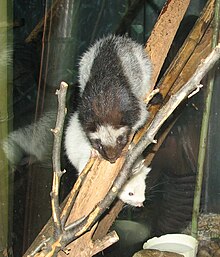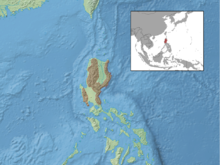The northern Luzon giant cloud rat (Phloeomys pallidus) or northern Luzon slender-tailed cloud rat, also known as bu-ot in Filipino, is a large species of rodent in the family Muridae. It is only found in Luzon, the Philippines.[1][2][3]
| Northern Luzon giant cloud rat | |
|---|---|

| |
| Scientific classification | |
| Domain: | Eukaryota |
| Kingdom: | Animalia |
| Phylum: | Chordata |
| Class: | Mammalia |
| Order: | Rodentia |
| Family: | Muridae |
| Genus: | Phloeomys |
| Species: | P. pallidus
|
| Binomial name | |
| Phloeomys pallidus Nehring, 1890
| |

| |
Appearance
editThis very large rodent weighs 1.9–2.6 kg (4.2–5.7 lb) and is 75–77 cm (29.5–30.5 in) long, including its tail.[3] The colour of its relatively long pelage, which also covers the tail, is highly variable, but usually it is mostly very pale brown-grey or white with some dark brown or black patches.[3] They often have a black mask and collar, but can also be entirely white.[2][3] The only other member of the genus Phloeomys, the southern Luzon giant cloud rat (P. cumingi), has a more southerly distribution, generally is smaller (although with some overlap) and it is entirely dark brown;[4] however, the occasional brown Northern Luzon giant cloud rat has been reported in the Mountain Province,[2] and the taxonomic limits between the two Phloeomys are not fully resolved.[1]
Distribution and habitat
editThe northern Luzon giant cloud rat is only found in northern and central part of Luzon, the Philippines.[1] It is found in at least 12 provinces.[2] The northern Luzon giant cloud rat prefers forest and scrub, but also occurs in degraded habitats such as plantations.[1] It occurs from sea level to an altitude of about 2,200 metres (7,200 ft).[3] In some areas it overlaps with the rarer giant bushy-tailed cloud rat, but that species mainly occurs at higher altitudes than the northern Luzon giant cloud rat.[3]
Behavior
editThe northern Luzon giant cloud rat is nocturnal and feeds on various types of vegetation.[3] Because of its relatively large size, it does not enter traditional small-mammal traps and this has limited research in the species.[5]
Reproduction
editNorthern Luzon giant cloud rats often live in pairs with one or two dependent young.[2] They give birth in hollow boles of trees (standing or fallen) or in burrows in the ground.[2] The sperm head of northern Luzon giant cloud rat has a short apical hook, with the sperm tail attached off-center basally.[6] The tail of the sperm is about 127 μm long.[6]
Conservation status
editThe northern Luzon giant cloud rat can cause extensive damage to rice crops and are sometimes considered a pest.[7] They are regularly hunted for food in the Sierra Madre.[8] It has been extirpated from some regions because of hunting,[3] but overall it appears to be able to withstand hunting pressure and in general it remains common and widespread.[1]
See also
editReferences
edit- ^ a b c d e f Heaney, L.; Balete, D.; Ong, P. (2016). "Phloeomys pallidus". IUCN Red List of Threatened Species. 2016: e.T17004A22454049. doi:10.2305/IUCN.UK.2016-2.RLTS.T17004A22454049.en. Retrieved 12 November 2021.
- ^ a b c d e f Oliver; et al. (1993). "Cloud rats in the Philippines — preliminary report on distribution and status". Oryx. 27: 41–48. doi:10.1017/s0030605300023942.
- ^ a b c d e f g h "Phloeomys pallidus". Field Museum of Natural History, Synopsis of Philippine Mammals. 2010. Retrieved 10 June 2011.
- ^ "Phloeomys cumingi". Field Museum of Natural History, Synopsis of Philippine Mammals. 2010. Retrieved 4 January 2020.
- ^ Duya; et al. (2011). "Chapter 4: Diversity of Small Mammals in Montane and Mossy Forests on Mount Cetaceo, Cagayan Province, Luzon". Fieldiana: Life and Earth Sciences. 2: 88–95. doi:10.3158/2158-5520-2.1.88. S2CID 129507111.
- ^ a b Breed; et al. (2010). "The spermatozoon of the Old Endemic Australo-Papuan and Philippine rodents--its morphological diversity and evolution". Acta Zoologica. 91 (3): 279–294. doi:10.1111/j.1463-6395.2009.00407.x.
- ^ Singleton; Ravindra & Sebastian (2008). Philippine Rats: ecology and management. PhilRice.
- ^ Duya; et al. (2007). "Report on a Survey of Mammals of the Sierra Madre Rance, Luzon Island, Philippines". Banwa. 4: 41–68.
